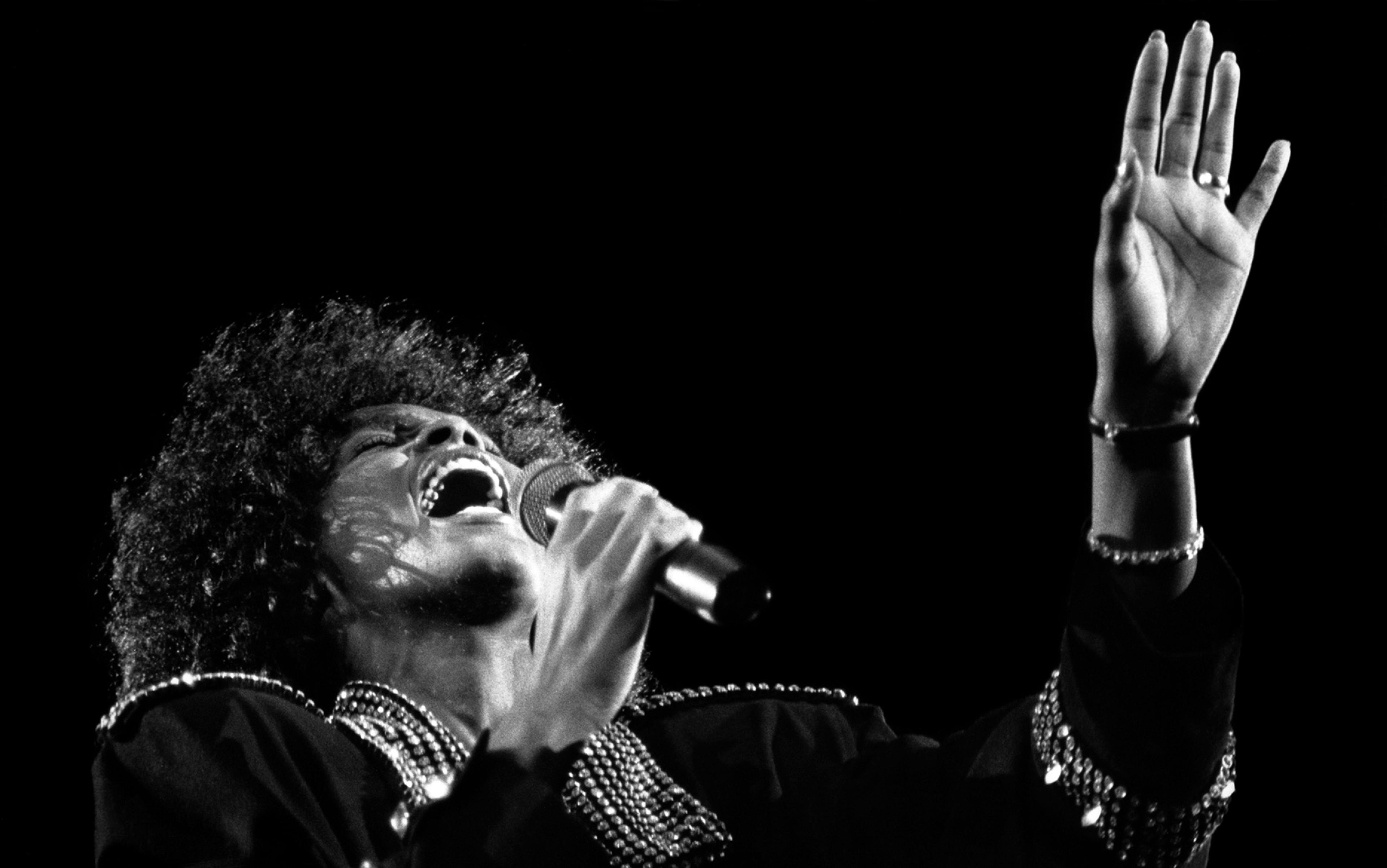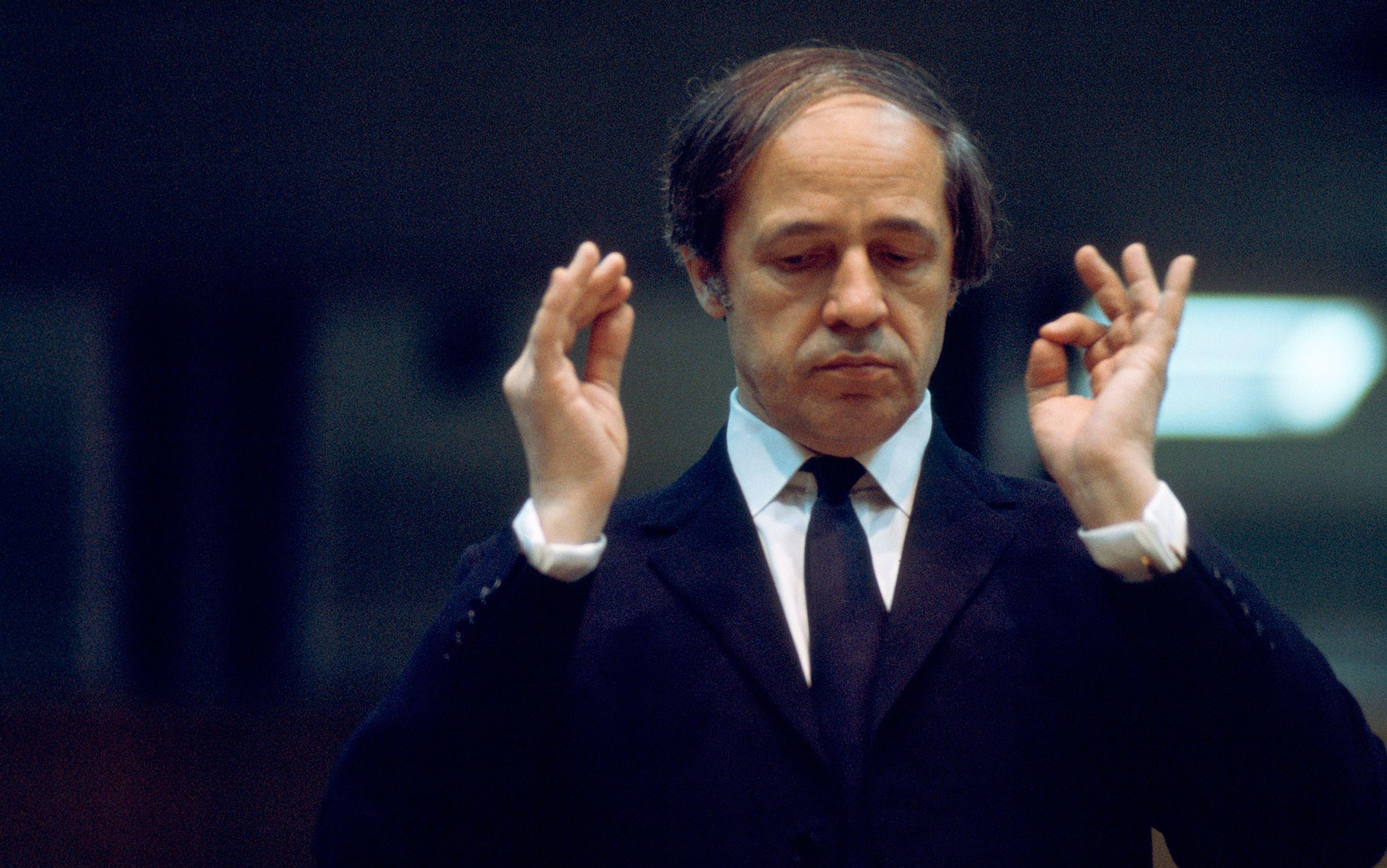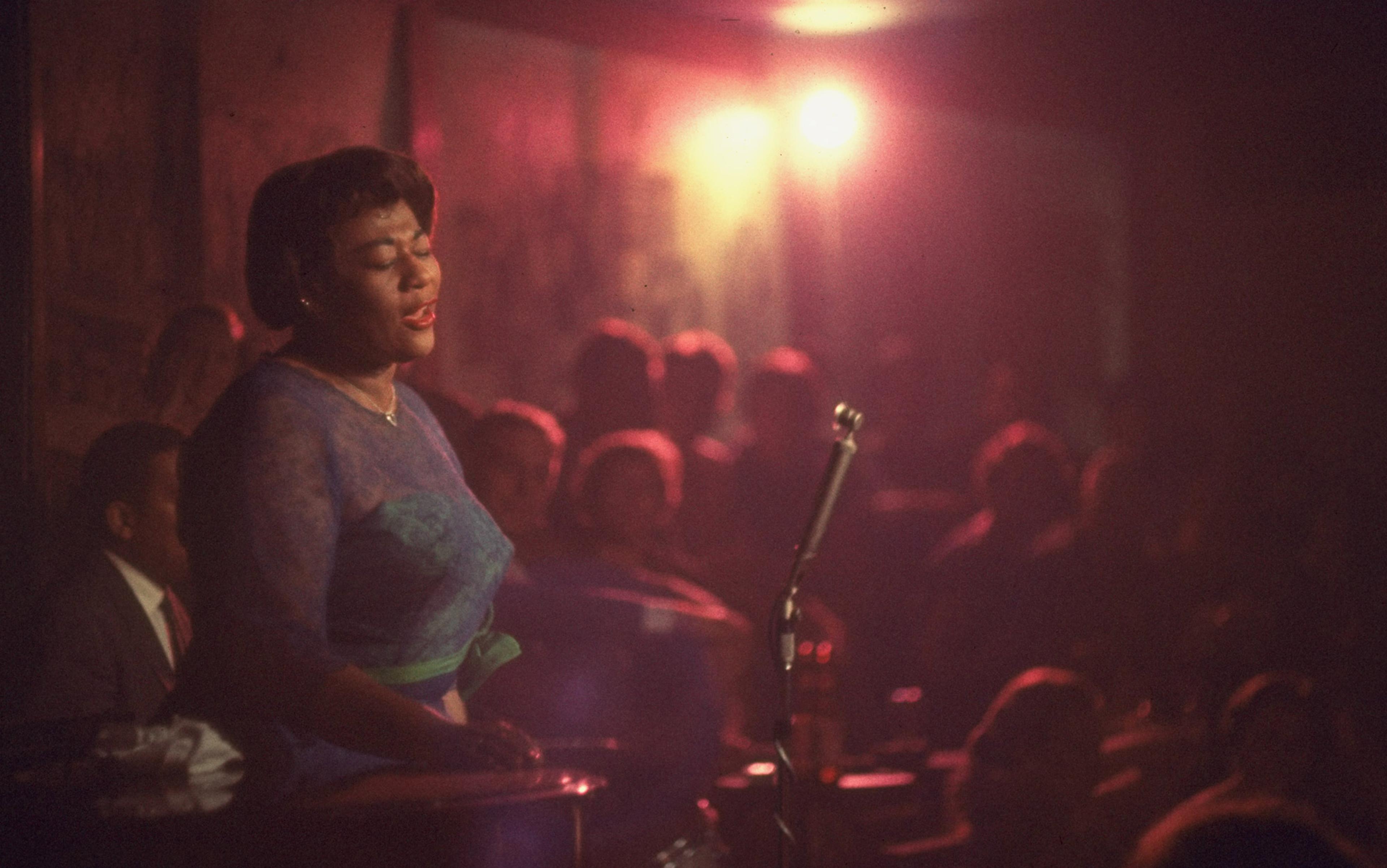Can music give you an orgasm? The short answer is yes. A longer answer will unlock the secrets of the evolution of music. But let’s begin with orgasms. Listen to Whitney Houston’s ‘I Will Always Love You’ from the film The Bodyguard (1992). She begins by singing quietly, breathily and alone, in a low register, with those strangely hesitant breaths between her words. As Houston gets into her stride, she stretches out her words with those soaring vocal runs characteristic of gospel music, whose effect here is to compound an emotion of trembling uncertainty. This is a perfect set-up for the song’s killer blow, when she finds certainty on an extremely long held tonic note swelling at the top of her register (the first note of the scale, but up an octave), with the words that complete the sense of the song: ‘And I will always love you.’ The melodic climax is underscored by the first entry of guitar and synth strings.
And then she repeats the cycle all over again, dropping back down and rising to a climax twice more, each wave higher and more confident than the one before. The second verse is more intense because the rhythm section, absent till now, finally comes in, and she sings louder and with more conviction. In verse three, she is joined by the saxophone. And for the third climax, Houston pulls the old trick of jacking up the key, and her voice breaks into a falsetto up a 5th for the final stratospheric ‘you’. I remember Houston’s song in the early 1990s stunning British pubs into silence, as drinkers succumbed to collective swooning at the final climax.
When I listen to Houston’s climax, my spine tingles and my heart races. I catch my breath. I get shivers running up and down my entire body, sometimes even a hot flush. I experience similar effects when I listen to Western classical music, as well as non-Western music. I swoon at the soprano’s stratospheric vocal leaps in Mozart’s concert arias, and at the ecstatic climax of a Pakistani qawwali (Sufi devotional song) sung by Nusrat Fateh Ali Khan. The music doesn’t need to be vocal – ‘Nimrod’ from Elgar’s Enigma Variations, or a raga performed by Ravi Shankar gets me every time.
But my physiological symptoms seem to be most visceral in vocal music, perhaps because, in listening to a singer, my larynx contracts sympathetically with their vocal gymnastics. Even when we don’t sing, we imagine that we do, just as we mirror each other’s posture and movement when we talk to each other. The reason is due to mirror neurons in our brain that give us the sensation of motion when they perceive motion in the outside world. On the basis of the mirror neuron system, the psychology professor Frank A Russo argues that observation of human song triggers ‘a spontaneous internal motor simulation’ by coupling our brain’s sensory and motor regions. So just listening to a singer can make us feel like we’re singing ourselves. I might be unable to follow Luciano Pavarotti up to his top B in Nessun dorma, yet my poor vocal cord can’t help but try, and that makes my head spin and my spine tingle.
Why does music give us a sensation analogous to sexual climax? Neuroscience calls these physiological effects ‘frisson’ or ‘skin orgasm’. The brain’s motor and reward systems are united in the striatum, deep within the subcortical basal ganglia of the forebrain. The upper, dorsal part of the striatum is responsible for action and prediction. The lower, ventral striatum is connected to the oldest and most emotional part of the brain called the limbic system. A team of neuroscientists at McGill University in Montreal, led by Robert Zatorre, discovered a direct link between these brain regions and musical ‘chills’, based on the release of dopamine.
Dopamine is a pleasure-inducing neurotransmitter associated with food, sex and drugs, and also music (but, unlike the other three, you can’t have too much of music: while it is just as addictive, it’s not bad for you in excess). Using positron emission tomography (PET scans), Zatorre’s lab measured how dopamine was released in the brains of eight subjects listening to their favourite pieces. The order of events is fascinating. When music starts to build to the climax during the anticipation phase, dopamine pours into the dorsal striatum. When the musical climax arrives, it triggers an emotional reaction in the ventral striatum. This is why listeners experience as much pleasure in imaginatively ‘moving’ towards the musical goal as when they reach it.
Love music has the same shape as sex, widening waves of desire deferring a climax for as long as possible
Skin orgasm is actually one of several names for this effect, including ‘the chills’, goosebumps and piloerection (when your hair stands on end) – terms that betray the surprising affinity of sex with fear. Or perhaps this connection is not so surprising, since sexual encounters can be terrifying. The composer Richard Wagner knew that, which is why, as a good proto-Freudian, he has his hero Siegfried in the Ring Cycle (1869-76) – ‘the boy who knows no fear’ – experience fear for the first time when he claps eyes on his first woman, Brünnhilde, on her rock. And this is why the musical effects that elicit skin orgasm in music, including shocks, screams and sudden contrasts of tempo, dynamics or pitch, would ordinarily be frightening if experienced in the real world. When those stratospheric high notes belted out by Whitney Houston or a Wagnerian heroine are performed in parts of the world that haven’t been exposed to that style of singing, such as in South Asia or most of Africa, they really do sound like screams. Growing up in a Western musical culture, we learn not to be afraid of these sounds, and even to like them.
Love music also has the same shape as sex, in the way that a song such as ‘I Will Always Love You’ gradually intensifies towards an ecstatic resolution. Houston’s song doesn’t just express love; it actually mimes the act of love in its slow build-up to its orgasmic top note. The shape of love – cumulatively widening waves of desire deferring a climax for as long as possible – is also staked out by Wagner’s Tristan und Isolde (1865), an opera that, notoriously, defers gratification for five hours.
It’s possible, however, that the link between music and sex is even more fundamental than that. Charles Darwin believed that human music evolved from sexual selection, most familiar in birdsong. Male birds sing to attract a mate, and this is why females prefer birds with longer, more complex and more numerous melodies, often sung by well-travelled, serially monogamous Lotharios such as nightingales. Not all animals sing, but those who do appear to confirm Darwin’s theory. Many species gather in choruses to sing together in the mating season. This phenomenon is called ‘lekking’, and it is epitomised by the synchronised chirps of male crickets. Although sexual selection is competitive, crickets chirp together because there is sonic strength in numbers, and it pays to pool their resources so that they can outperform rival choruses. Moving from the smallest to the largest animals – and those with the heaviest brains on the planet – we see that lekking is also performed by pods of male humpback whales, who usually sing in spring, during the mating season. And for Homo sapiens, music has always been the food of love. There is no need to belabour the phallic magnetism of a rock star’s guitar, nor the rich tradition of serenades and love songs.
Competitive sexual display is not confined to the sonic dimension, of course. The visual beauty of the peacock’s tail or the bowerbird’s nest fulfils the same adaptive function. And sexual display can explain why 1.8 million years ago Homo ergaster, one of our hominin ancestors, created symmetrical biface hand-axes, the so-called Acheulian biface. To female hominins, the biface would have been as sexually alluring as a peacock’s tail, partly because it signalled the adaptive advantage of the intelligence it had taken to make it. A hominin capable of knapping such a tool would have been a superior mate. Is there a link with the origins of human music? Psychologists claim that the faculty of symmetry is cross-modal, crossing between vision and sound. The analogue of visual symmetry is beating in regular time – rhythm. And these symmetrical rhythmic patterns would have been enjoyed in themselves, just as a female bird would have appreciated the visual beauty of a male peacock’s plumage, over and above its adaptive function. There is a vital difference between beating in time to carve a flint, and regular rhythmic patterns in their own right, away from their place or function within a quarry.
Sad tunes droop in descending contours, mimicking the way grief pulls us down and saps our energy
But Darwin believed that human music evolved from animal mating calls far more directly than that. In his view, musical evolution was the process by which hominins gradually refined and articulated the passions of animal cries. Of course, the idea that music is the ‘language’ of emotions is old news (though, strictly speaking, music isn’t really a ‘language’ at all, since it doesn’t represent concrete things such as pencils or teaspoons, and it expresses our feelings with much greater immediacy than words or concepts). The idea was popularised in the 18th century by philosophers such as Jean-Jacques Rousseau. Darwin’s contribution was to give this thought a radical evolutionary spin with his insight that human and animal emotions were similar. In particular, we share with birds, whales and nonhuman primates a basic set of emotions, such as love, sadness, fear and anger. In his book The Expression of the Emotions in Man and Animals (1872), Darwin argued that, far from being irrational or decorative, emotions had adaptive functions that helped animals survive in a hostile environment. Fear makes an animal run; anger energises it to attack; love is an emotion of attachment; sadness is a therapeutic response of loss. Whether the environment is a rainforest, a financial trading room or a school playground, these emotions do the same job. Animal and human emotions aren’t just similar; they perform comparable adaptive functions.
So how do these animal passions translate into the emotions of human music? In 1989, when the Panamanian dictator Manuel Noriega was holed up in the Vatican’s embassy to evade capture by the US Army, they surrounded the building with speakers playing music at maximum volume in order to compel him to surrender. Of course, they didn’t bombard him with Céline Dion, but rather endless hard rock, since its aggressive power chords express the emotion of anger.
Or take the screeching violins in the shower scene of Alfred Hitchcock’s Psycho (1960), courtesy of Bernard Herrmann. These are sonic analogues of Anthony Perkins’s stabbing gestures, but they go equally well with Janet Leigh’s screams of terror: Hitchcock knew that anger and fear are two sides of the same coin. Tomaso Albinoni’s Adagio in G minor – at No 5 in the Daily Telegraph’s poll of the top 78 funeral songs – is sad because it is saturated with weeping gestures called ‘appoggiaturas’ (strangely, the No 1 funeral song is Monty Python’s ‘Always Look on the Bright Side of Life’). In 2012, The Wall Street Journal ran a feature on why Adele’s ‘Someone Like You’ makes people cry, and they also put it down to its appoggiaturas – descending, sigh-like ornaments that clash with the harmony.
Sad tunes also tend to droop in descending contours, mimicking the way grief pulls us down and saps our energy. Conversely, when we’re proud, we stand up straight and puff out our chests. Edward Elgar’s Pomp and Circumstance Marches audibly do that. We catch La Marseillaise’s revolutionary fervour from its opening fanfares; these drive the music forward just like military music propels armies. The biggest stroke of genius in all film music was to use double-bass rumbles to suggest an approaching shark. But long before Steven Spielberg’s Jaws (1975), Hector Berlioz used the same idea in the slow movement of his Symphonie fantastique (1830) to evoke the distant thunder of an approaching storm. In fact, Spielberg couldn’t resist recycling this genius idea twice more, for the T-Rex in Jurassic Park (1993) and the tank in Saving Private Ryan (1998).
Musical happiness is more elusive because, in some ways, all music makes us happy; we even enjoy sad music at some level. It turns out that happy music is formally simpler and more conventional, because, from an evolutionary perspective, happiness means fulfilling a goal. The song ‘Happy Birthday to You’ is a perfect little gem of conventional simplicity and goal-fulfilment. Happy music loves symmetry and repetition: a concise opening phrase (‘Happy birthday to you’) is answered by a modified repeat. Happy music needs to wander off-course so as to be able to return in triumph. The song’s second half is more continuous (ie, without the symmetrical repeat), more complex, attains the melodic highpoint (‘happy BIRTHDAY, dear…’) and smuggles in a final repeat at its end. ‘Three Blind Mice’, ‘Twinkle, Twinkle Little Star’, and Beethoven’s ‘Ode to Joy’ (1824) all work on the same principle: opening repetition, digression, return. They also epitomise happiness’s liking for stepwise descending patterns, simulating the law of gravity. What goes up must come down, in a nice balanced arc.
Lurking under these claims is that same old fallacious chestnut, that ‘music is a universal language’. To be sure, every culture on our planet has music, and every human is born with the capacity to become a musician. But that emphatically does not mean that the music of India, Vietnam, Ghana, Brazil, Paris and the Solomon Islands share the same scales, rhythmic patterns or musical instruments. Obviously, they don’t. The Javanese pelog and slendro scales are based on distinctive tuning systems, and can’t be mapped on to European seven-note scales. The Western propensity for binary metrical patterns – such as the ‘four-on-the-floor’ groove in pop, or Mozart’s symmetrical phrases – sounds simple-minded to West African drummers adept at complex polyrhythms. The ensemble of sitar melody, tabla percussion and tanpura drone is instantly recognisable across the world as the sound of North Indian classical music. More broadly, most non-Western music does without harmony and counterpoint, preferring to decorate a single melody in multiple voices or support it with a drone. Hence on the surface, the myriad musics of our world sound not just distinct, but non-commensurable with each other.
Again, Darwin has an answer. He shrewdly titled his book ‘the expression of the emotions’, rather than just ‘the emotions’. Darwin grasped that people and animals might well feel similar emotions, yet communicate them through different facial expressions and physical gestures. There is a useful analogy here with emotion in language. To access the sadness, say, of a Japanese haiku, you must know Japanese. Similarly, in Japanese culture smiling is a social convention and does not necessarily express happiness. Psychologists of emotion call these conventions ‘display rules’. It’s certainly possible that animals and humans across times, cultures and species barriers share emotions. But that doesn’t mean that they share display rules for expressing them.
Whale songs are closer to the chanting in football terraces than to serenades
How do these ideas leave music and sex? It’s more complex than Darwin thought, thanks to a century and a half of research in zoology. We now know things about animal communication that seem to go against Darwin’s theory that music originates in mating calls. It turns out that, although only humpback males sing, and although they usually only do so in the mating season, when they gather in vast lekks to trumpet out their beguiling, complex songs, there are no females around to hear them. The males sing for themselves, ostensibly for solidarity. Whale songs are closer to the chanting in football terraces than to serenades. Birdsong might be similarly social rather than sexual. In fact, the dogma that female birds don’t sing was a reflection of Victorian prurience about female pleasure, and their prejudice against female composers (it’s no accident that Western music history tends to omit women). We now know that female birds do sing, and for social bonding rather than for sexual selection. And in the world of nonhuman primates, we now realise that the majority of ape and monkey vocalisations have nothing to do with sex. Many calls promote social bonding through what the anthropologist Robin Dunbar calls ‘vocal grooming’ – grooming each other through sound rather than touch. And many are danger signals, like the four famous calls of the vervet monkeys that signify the presence of four predators: leopards, eagles, snakes or baboons. Darwin is wrong, then, in the sense that his two theories disagree with each other. His theory that animal emotions arise from adaptive behaviours is still quite plausible. However, there are lots of different kinds of behaviour other than mating. So his idea that human music evolved from just a single behaviour – mating – is unnecessarily reductive.
The origins of music and language are much more intertwined than Darwin thought. The consensus now is that these two channels of communication couldn’t be meaningfully distinguished from each other until H sapiens became intellectually mature, probably around 100,000 years ago. That is, when we talk of bird or whale ‘song’, we could just as well be speaking about language. Indeed, when NASA compiled their Golden Record, carried by Voyager on its journey into outer space, it chose to categorise whale song not as music but side-by-side with 55 greetings in Earth languages – hence, implicitly, a kind of language itself. Australopithecines, among our earliest hominin ancestors, probably sounded like a gorilla or a chimpanzee, with whom we share 98 per cent of our genes. A primitive form of the FOXP2 gene, associated with language acquisition, has been recovered from Neanderthal remains, suggesting that our cousins communicated in a language close to song.
After H sapiens arrived around 300,000 years ago, music and language split and evolved as separate idioms, albeit with echoes of each other. Thus language mimics music in its prosody: speech is musical because it has rhythm, contour, loudness and the voice’s tone quality, although grammar and semantics are placed front and centre. And music mimics language in having grammar, although rhythm, contour, loudness and timbre are dominant. The fact that music didn’t wither away and die after language had fully evolved proves that it still plays a vital and much-valued role in human existence. Indeed, given that animal communication is far older than language, this suggests that music played a more significant role in human evolution. This is why my new book, The Musical Human (2021), proposes that music is the most important thing our species ever learned to do.
Returning to Houston’s ‘I Will Always Love You’, we can now see that its emotion isn’t sexual after all. Its effects of anticipation and release are based on the much more general principles of how the brain understands patterns. Leonard Meyer, the American music theorist who cracked the riddle of musical emotion in the 1950s, realised that all music was based on patterns, some of which were natural (or psychologically hardwired), such as the expectation that a scale will continue in the same direction that it began; some of which are learned, such as the convention that a verse in a pop song will lead to a chorus. Composers tread a tightrope between novelty and redundancy. Too much change, and the listener is lost. Too little, and the listener is bored. Emotion is induced when a pattern is interrupted or subverted in some way. It is like when someone creeps up behind you and says ‘Boo!’ Emotion in music as in life originates in the fear of the startle reflex. Musical emotion is the distillation of surprise, as in the manipulative shocks in Joseph Haydn’s Surprise symphony (1792). But Meyer found that emotion also arises when a pattern is fulfilled, when it reaches its goal. The evidence rests that musical emotion swings back and forth between the subversion and resolution of expectation, between anticipation and climax.
Musical emotion is most intense when our evaluation of something switches from negative to positive. Indeed, the intensity is proportionate to the contrast. Psychologists call this principle ‘contrastive valence’. Judging from the hundreds of millions of views it has since received on YouTube, contrastive valence on a global scale was elicited by the singer Susan Boyle’s first appearance on the TV show Britain’s Got Talent in 2009. The video is a test-case of social stereotyping, and has become a subject of learned academic studies. Presented as an ungainly middle-aged woman, Boyle stands on stage, mocked by both the judges and the audience. But as soon as she starts to sing ‘I Dreamed a Dream’ from the musical Les Misérables, derision turns to surprise and steadily mounts to ecstatic enthusiasm. The audience rise to their feet; their enthusiasm climaxes with the melody’s own highpoint, the goal of its rising scale. It is a perfect emotional storm, an extraordinary coming together of surprise, contrastive valence, melodic anticipation and climax, catching fire virally across the planet. The immediate response of Piers Morgan, one of the judges, could hardly have been scripted better: ‘That was the biggest surprise I have had in three years of this show.’ I am not ashamed to admit that I blub whenever I watch this video; whether cynically or, more likely, through happenstance, it presses all the emotional buttons. It is instructive to compare it with Anne Hathaway’s equally remarkable Oscar-winning performance of ‘I Dreamed a Dream’ in the film of Les Misérables (2012). Hathaway makes us cry because we sympathise with Victor Hugo’s tragic heroine. The Boyle video makes us cry because it subverts a pattern, a social stereotype.
I don’t think that the emotional climax of Boyle’s performance has anything to do with sex, although the shape of it is practically identical with Houston’s. We might choose to call its effect on us ‘skin orgasm’, but that is just a euphemism for something even more fundamental than sexual arousal. What is that? Pattern and anticipation are possible only because humans have a grasp of regular time intervals. Our ability to predict what comes next is linked to the evolution of walking on two feet, to bipedalism. Walking might have taught our brain its sense of time, and time is perhaps the brain’s internal simulation of the periodic motion of footsteps (averaging about one step every several 100 milliseconds). In other words, the first step towards human music happened 4 million years ago when Australopithecines got up on their hind legs and took their first step.
If that was humankind’s first step up the musical ladder, then its last step is not a physiological climax. The summit of music is much higher – and deeper – than that. Yes, musical pleasure might well be among the most intensely enjoyable experiences that we know, up there with sex, food and drugs. Yet we treasure music because it has a human and spiritual dimension that can no more be reduced to chemicals or neurons than love can be reduced to sex.
To read more about music and the emotions, visit Psyche, a digital magazine from Aeon that illuminates the human condition through psychology, philosophy and the arts.






